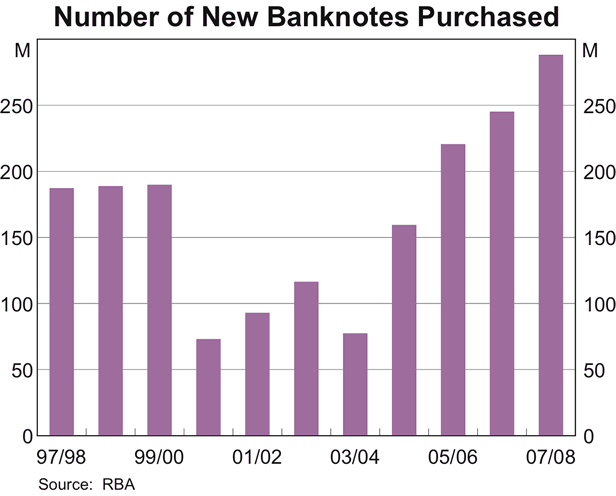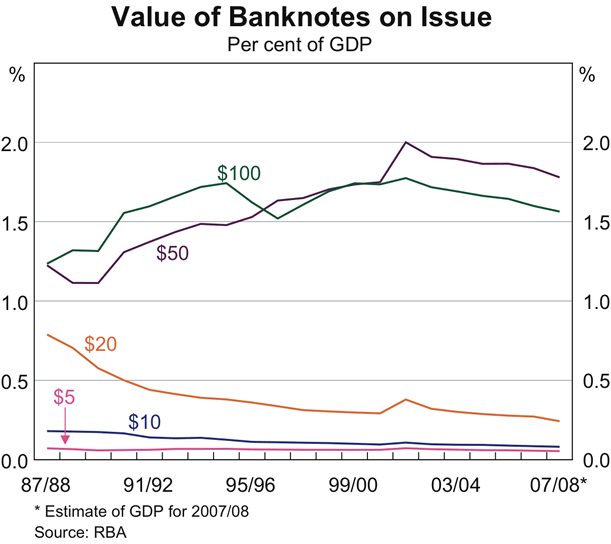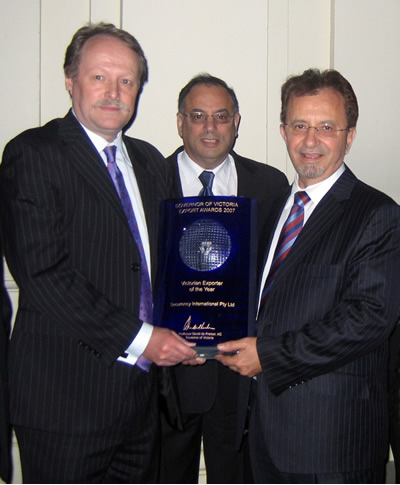Reserve Bank of Australia Annual Report – 2008 Currency
In early 2008 the Reserve Bank decided to bring together the oversight of all its activities related to banknotes under a single Assistant Governor (Currency), who is responsible for the Note Issue Department of the Reserve Bank and also chairs the Boards of Note Printing Australia Limited (NPA), the wholly owned subsidiary that prints Australia's banknotes, and Securency International Pty Ltd, the joint-venture company that produces the polymer substrate used for Australia's banknotes (and those for many other countries as well). As part of this reorganisation, Graeme Thompson stepped down from the chairs of both NPA and Securency, positions he had held since the two organisations were first incorporated in the 1990s. The Bank thanks Mr Thompson for his contribution to the development of the two companies over many years. John Akehurst, a member of the Reserve Bank Board, joined the Securency Board in July 2008.
Note Issue
The Reserve Bank is responsible for the production and issuance of new banknotes and the destruction of old, unfit banknotes. It also must ensure that the public retains confidence in the currency, such that banknotes remain an effective payment mechanism and store of wealth. The Bank maintains this confidence by:
- making sure that there are always enough banknotes available to meet the public's demand;
- maintaining a high quality of banknotes in circulation; and
- conducting research to ensure that the currency remains secure against counterfeiting.
New Banknote Purchases
The Reserve Bank purchased 288 million new banknotes from NPA in 2007/08, an increase of 43 million banknotes from that purchased in the previous year. The order consisted of 52 million $5 banknotes, 61 million $10 banknotes, 103 million $20 banknotes, and 72 million $50 banknotes. Although no $100 banknotes were purchased in 2007/08, the Reserve Bank's stock of $100 banknotes, acquired in 1999 as part of Y2K contingency preparations, has been run down to a level where a quantity of new $100 banknotes is expected to be purchased in 2008/09.
Banknotes on Issue
Most of the new banknotes purchased by the Reserve Bank were used to replace unfit banknotes or added to the Bank's inventories. Over the year, therefore, the number of banknotes in circulation increased only modestly, to 930 million at the end of June 2008. These had a value of $42.1 billion. This is equivalent to 44 banknotes, worth $1,970, for every Australian. The $50 banknote accounted for nearly half of the value of banknotes on issue and 43 per cent of the number of banknotes on issue, while the $100 banknote accounted for 42 per cent of the value and 19 per cent of the number of banknotes on issue.

Over the past 15 years, in line with the broad experience in many other developed countries, the growth in the value of banknotes in circulation has largely matched the nominal growth of the economy, and the value of banknotes on issue has remained generally between 3¾ and 4 per cent of nominal GDP.

Notwithstanding this stability, the denominational split has changed considerably over this period. A decline in the share of $20 banknotes has been mirrored by an increase in the share of $50 banknotes. This is largely a refl ection of $50 banknotes replacing $20 banknotes as the primary banknote dispensed from ATMs. Currently, 75 per cent of banknotes dispensed from ATMs are $50 banknotes, whereas in the 1990s this share was closer to 50 per cent.
| At End June | $5 | $10 | $20 | $50 | $100 | Total(a) | Total
(per cent of GDP) |
|---|---|---|---|---|---|---|---|
| 2004 | 533 | 791 | 2,533 | 15,941 | 14,224 | 34,022 | 4.0 |
| 2005 | 539 | 837 | 2,584 | 16,740 | 14,924 | 35,624 | 4.0 |
| 2006 | 572 | 857 | 2,690 | 18,044 | 15,903 | 38,066 | 3.9 |
| 2007 | 591 | 894 | 2,846 | 19,228 | 16,730 | 40,289 | 3.8 |
| 2008 | 614 | 917 | 2,732 | 20,111 | 17,690 | 42,064 | 3.7* |
| (a) Includes $1 and $2 banknotes remaining on issue. * Estimate of GDP for 2007/08. | |||||||
Distribution
A core objective of the Reserve Bank is to ensure that there are sufficient banknotes to meet the public's demand. In addition to the surplus stocks of banknotes maintained by the Bank, the commercial banks also maintain a surplus stock of banknotes in approved cash centres located throughout Australia. These stocks are designed to ensure that there are sufficient banknotes to meet their customers' day-to-day currency requirements. In addition to dealing directly with each other, commercial banks are also able to replenish these stocks from the Reserve Bank's National Note Processing and Distribution Centre (NNPDC), located within NPA at Craigieburn, Victoria.

Banknotes deemed to be unfit by the commercial banks and armoured car companies are returned to the NNPDC and processed through high-speed sorting equipment to confirm their quality and authenticity. Returned banknotes that are subsequently deemed to be fit by the NNPDC are re-issued. Unfit banknotes are destroyed. Of the 199 million banknotes returned to the NNPDC during 2007/08, 107 million were identified as being unfit for re-issue and were destroyed.
During 2007/08, the Reserve Bank issued 228 million banknotes from the NNPDC, with a face value of $8 billion. Of these banknotes, 80 million were banknotes that had previously been in circulation, while 148 million were new banknotes. The remainder of the purchased new banknotes were added to the Reserve Bank's inventories, to be issued as required.
Banknote Quality
Another objective of the Reserve Bank is to achieve a high quality of banknotes in circulation. This maintains the functionality of banknotes for handling by the public and for processing through the various banknote accepting and dispensing machines that are increasingly present in the community. High-quality banknotes also assist the public's detection of counterfeits. This objective requires that the Reserve Bank issues high-quality banknotes and that unfit banknotes are efficiently withdrawn from circulation.
The commercial banks and armoured car companies play an important role in achieving this quality objective. Specifically, under the Note Quality Reward Scheme, the Reserve Bank reimburses banks and armoured car companies for outsorting unfit banknotes from circulation.
Since this scheme was introduced in September 2006, there has been a significant improvement in banknote quality, though the improvement in quality has been greatest for the higher denomination banknotes. A contributing factor is that lower denomination banknotes tend to remain in circulation relatively longer than higher denomination banknotes, before being returned to financial institutions for fitness sorting and ultimately to the NNPDC for assessment and destruction.
Some banknotes become damaged in circulation beyond the normal levels of wear and tear and become unsuitable for sorting through high-speed sorting equipment. The Reserve Bank has a policy of paying value for severely damaged banknotes that can be authenticated as genuine Australian banknotes, subject to the amount of the banknote that remains recognisable. Although commercial banks can assess damaged banknotes and pay the assessed value for them, all damaged banknotes are returned to the NNPDC for final assessment and destruction. Under this policy, most damaged banknotes receive full value. However, where a large piece of a banknote is missing, only the appropriate partial value is paid.
During 2007/08, the NNPDC assessed around 24,000 banknote claims, and paid value of around $6.5 million. While the number of claims was 15 per cent less than in the previous year, the value of claims paid was significantly higher. A major contributing factor for this was the large amount of claims related to contaminated banknotes received following the widespread flooding of parts of northern New South Wales and Queensland.
Counterfeiting in Australia
As part of its objective of maintaining public confidence in Australian banknotes, the Reserve Bank monitors the incidence of counterfeits detected in Australia. Almost all counterfeits of Australian banknotes are of poor quality, printed on a paper substrate and easily identified by feel as well as by visual inspection.
| $5 | $10 | $20 | $50 | $100 | Total | |
|---|---|---|---|---|---|---|
| Number | 60 | 173 | 415 | 5,281 | 1,059 | 6,988 |
| Nominal Value ($) | 300 | 1,730 | 8,300 | 264,050 | 105,900 | 380,280 |
| Parts per million | 0.5 | 1.9 | 2.9 | 13.0 | 6.1 | 7.4 |
Compared with the volume of genuine banknotes in circulation, the number of counterfeits passed remains very low. In 2007/08, about 7,000 counterfeits were detected with a nominal face value of around $380,000. Over the past year, about seven counterfeits were detected per million genuine banknotes in circulation, up from around six counterfeits detected per million banknotes in 2006/07. As in previous years, the $50 banknote is the most heavily counterfeited denomination, accounting for around 75 per cent of all counterfeits passed.
The Reserve Bank maintains a close relationship with Australian Federal and State law enforcement agencies in monitoring developments in counterfeiting activity. In an effort to improve the timeliness of counterfeiting data in Australia, and to reduce administrative costs, the Bank and the Australian Federal Police are working together to develop new administrative and processing procedures for the handling and assessment of counterfeits. These procedures are likely to involve the transfer of some administrative responsibilities to the Reserve Bank.
Banknote Research and Development
To ensure a continuing low level of counterfeiting activity in Australia, the Reserve Bank works closely with NPA and Securency to facilitate the development of new security features for polymer banknotes. For many years, the Bank has funded a range of research initiatives undertaken by NPA's Technical Development Group. In the past, this work has resulted in significant new developments, such as the polymer substrate now used in all Australian banknotes and in many other countries.
In order to co-ordinate these research and development activities more effectively, and facilitate co-operation with other central banks, the Reserve Bank decided to take direct responsibility for them. Accordingly, on 1 July 2008 the Technical Development Group at NPA was transferred to the Bank's Note Issue Department. It will remain located in Craigieburn and continue to work closely with staff at NPA and Securency, as well as develop new links to other banknote research groups around the world.
The Reserve Bank's research group will also continue to participate with NPA and Securency on a Joint Technical Committee, which facilitates mutual discussion and review of research proposals and programs in all three organisations, with the aim of maximising enhancements to the polymer banknote technology.
Numismatics
In late 2007, the Reserve Bank conducted its first annual auction of Australian numismatic banknotes. Some 60,000 first and last prefix banknotes produced in 2006 were offered through two channels: a public auction in Melbourne on 2 November 2007 and an online auction held between 22 October and 9 November 2007. In conjunction with the online auction, standard uncirculated banknotes were also offered for sale. Most of the banknotes sold attracted prices at or close to the reserve, while some banknotes with serial numbers of special interest to collectors sold well above their reserve prices.
The second of these annual numismatic auctions was held during June and July 2008, comprising banknotes produced in 2007. The process and results were similar to those in 2007.
The Reserve Bank intends to review the results of the 2007 and 2008 auctions before deciding whether to continue to offer numismatic products in this way in future.
Note Printing Australia
Note Printing Australia Limited is a wholly owned subsidiary of the Reserve Bank located at Craigieburn, Victoria. It produces Australian banknotes for the Reserve Bank and Australian passports for the Department of Foreign Affairs and Trade, and operates the NNPDC under a contract from the Reserve Bank. It also supplies banknotes to a number of other countries in the Asia-Pacific region and banknote security products to a number of overseas banknote printers.
NPA is overseen by a Board, which has a charter from the Reserve Bank Board emphasising the efficient production of Australian banknotes to the Reserve Bank's specifications and the continuing support of the polymer currency note technology pioneered by NPA and now supplied and supported primarily by Securency. The NPA Board comprises Bob Rankin, Assistant Governor (Currency) and Chairman; Richard Warburton AO; Les Austin, a former senior Reserve Bank officer; and Darryl Ross, the Reserve Bank's Chief Financial Officer. NPA's Chief Executive is Bernhard Imbach.
In 2007/08, NPA produced 470 million banknotes, of which 288 million were Australian banknotes for the Reserve Bank and 182 million were banknotes for export. This volume is in line with the level of production in recent years. Export customers during the year included the Brunei Currency and Monetary Board, Banco Central de Chile, Bank Negara Malaysia, the Reserve Bank of New Zealand and the Bank of Papua New Guinea.
During the year, NPA printed and assembled 2.0 million Australian passports, up from 0.8 million the previous year. Work also continued on a new design for Australian passports, which is expected to be introduced later in 2008.
Investment at NPA in recent years has focused on improving process controls, print quality and productivity. A major investment has been made in the pre-press area, which manufactures the plates used on the printing presses. This area is now entirely digital. NPA has now decided to undertake a significant further investment to bring its key production equipment up to the most advanced technology standards available. This investment program, which will be implemented over the next two years, will be supported by a new subscription of capital from the Reserve Bank of $40 million, bringing the total capital of the company to about $100 million.
NPA earned a profit after tax of $6.4 million in 2007/08, up from $5.1 million in 2006/07. NPA's financial accounts are consolidated with the accounts of the Reserve Bank.
Securency
Securency International Pty Ltd is a joint venture between the Reserve Bank and Innovia Films, a global supplier of polypropylene films based in the United Kingdom. Securency manufactures high-security substrates for banknotes and other security documents by applying proprietary coatings and security features to the specialised films supplied by Innovia. The range of substrates made at present by Securency comprises Guardian® for banknotes, Sentinel® for security documents such as land titles, and Sentrii® for security cards.
Securency's Board comprises three directors appointed by the Reserve Bank, three appointed by Innovia, and the company's Managing Director, Myles Curtis, as a nonvoting director. The directors appointed by the Reserve Bank are Bob Rankin (Chairman), Les Austin and John Akehurst (a member of the Reserve Bank Board). Securency's headquarters are in Craigieburn, Victoria, adjacent to both NPA and Innovia's Australian film manufacturing plant.
The increasing success of polymer banknote technology, and the resulting increases in production of Guardian® substrate, has necessitated a rapid expansion of Securency's production capacity in recent years. After a second production line was commissioned in Craigieburn in early 2007, work has commenced on another new production facility in Queretaro, Mexico, which is scheduled to be commissioned late in 2008. The Mexican plant is owned by Securency Mexico SACV, a joint venture with Banco de Mexico, the Mexican central bank. It is expected that the Mexican plant will supply the growing demand for polymer banknotes in Latin America, as well as provide contingent support for the Craigieburn plant.

In order to facilitate the joint venture in Mexico, Securency underwent a corporate re-organisation in 2007, in which a new holding company, Securency International Pty Ltd, was established to undertake marketing and corporate services and to own all intellectual property associated with the polymer banknote technology. Securency International is also the partner with Banco de Mexico in the Securency Mexico joint venture, which will be responsible for manufacturing operations in Mexico. The existing Australian manufacturing operations are now undertaken by the newly established Securency Australia Pty Ltd, a wholly owned subsidiary of Securency International.
Securency has always had a strong commitment to research and development. In 2008, work commenced on the construction of a new research centre in Craigieburn, which will house the company's research team and provide improved facilities for both research on new security features and their development to production stage. The centre is scheduled to be in operation by 2009.
Securency supplied Guardian® substrate in the past year for 13 countries, comprising Australia, Brunei Darrussalam, Chile, Guatemala, Hong Kong, Malaysia, Mexico, New Zealand, Nigeria, Papua New Guinea, Romania, Singapore and Vietnam. Twenty-six countries have now issued banknotes using Securency's polymer substrate since the first such banknote – the Australian $10 banknote issued in 1988 to commemorate the bicentenary of European settlement in Australia – was issued 20 years ago.
Securency earned a profit after tax of $13.5 million in 2007, about the same as in 2006. The Reserve Bank equity accounts for its investment in Securency.